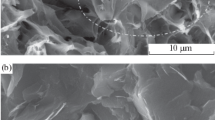Abstract
The electrical percolation and hybrid effect that forms from long carbon fiber (LCF) and long glass fiber (LGF) hybridized composite in a polypropylene matrix were studied by investigating electrical and mechanical properties. As a process, the electrical and mechanical properties were investigated in terms of LCF loading at constant volume percentage in the total. The electrical resistivities of volume and surface were measured in order to learn the percolation threshold points, which were 8–9 and 10–12 volume percents of LCF loading individually. The mechanical properties, such as, were tensile and flexural modulus of the hybridized composite were obtained and compared with the prediction results using the rule of hybrid mixtures (RoHM) equation. The hybrid effect was observed in the result of the tensile modulus in the range of 6–10 volume percent of LCF loading whereas there was no hybrid effect in flexural modulus. The tensile and flexural strengths of LCF/LGF hybridized composite are 100 and 140MPa at 20 vol% of LCF loading. The tensile and flexural modulus are approximately 22 and 14 GPa at 20 vol% of LCF. The interaction between reinforced fiber and the matrix was reported and analyzed by scanning electron microscopy (SEM) and heat depletion temperature (HDT). Through the process, the mechanical strength was more related to the interaction between fiber and the polypropylene matrix than the mechanical modulus.

Similar content being viewed by others
References
Thermoplastic Composite Materials, J. M. Crosby and L. A. Carlsson, Eds., ELSEVIER, 1991.
C. Wang, W. Cai, X. Lu, and J. Chen, Energy Conversion and Management, 48, 2110 (2007).
J. L. Thomason, Compos. Part A: Appl. Sci. Manuf., 33, 1641 (2002).
J. L. Thomason, Compos. Part A: Appl. Sci. Manuf., 36, 995 (2005).
J. L. Thomason and W. M. Groenewoud, Compos. Part A: Appl. Sci. Manuf., 27, 555 (1996).
J. L. Thomason and M. A. Vlug, Compos. Part A: Appl. Sci. Manuf., 27, 477 (1996).
J. L. Thomason and M. A. Vlug, Compos. Part A: Appl. Sci. Manuf., 28, 277 (1997).
J. L. Thomason, M. A. Vlug, G. Shipper, and H. G. L. T. Krikor, Compos. Part A: Appl. Sci. Manuf., 27, 1075 (1996).
F. W. J. van Hattum, C. Leer, J. C. Viana, O. S. Carneiro, M. L. Lake, and C. A. Bernardo, Plast. Rubber Compos., 35, 247 (2006).
G. A. Wade, W. J. Cantwell, and R. C. Pond, Interface Science, 8, 363 (2000).
T. P. Skourlis, C. Chassapis, and S. Manoochehri, J. Thermoplast. Compos. Mater., 10, 453 (1997).
S. -Y. Fu, B. Lauke, E. Mader, C.-Y. Yue, and X. Hu, Compos. Part A: Appl. Sci. Manuf., 31, 1117 (2000).
R. Taipalus, T. Harmia, M. Q. Zhang, and K. Friedrich, Compos. Sci. Technol., 61, 801 (2001).
S. -Y. Fu, B. Lauke, E. Mader, C.-Y. Yue, X. Hu, and Y.-W. Mai, J. Mater. Sci., 36, 1243 (2001).
A. Markov, B. Fiedler, and K. Schulte, Compos. Part A: Appl. Sci. Manuf., 37, 1390 (2006).
K. I. Winey, T. Kashiwagi, and M. F. Mu, MRS Bulletin, 32, 348 (2007).
S. Kim and L. T. Drzal, J. Adhes. Sci. Technol., 23, 1623 (2009).
N. Sato, T. Kurauchi, S. Sato, and O. Kamigaito, J. Mater. Sci., 26, 3891 (1991).
P. Nygard, K. Redford, and C.G. Gustafson, Compos. Interfaces, 9, 365 (2002).
Y. C. Ke, C. F. Long, and Z. N. Qi, J. Appl. Polym. Sci., 71, 1139 (1999).
A. C. Balazs, T. Emrick, and T. P. Russell, Science, 314, 1107 (2006).
M. Z. Rong, M. Q. Zhang, Y. X. Zheng, H. M. Zeng, R. Walter, and K. Friedrich, Polymer, 42, 167 (2001).
Author information
Authors and Affiliations
Corresponding author
Rights and permissions
About this article
Cite this article
Lee, D.W., Ma, S. & Lee, K.Y. Electrical and mechanical properties of carbon/glass hybridized long fiber reinforced polypropylene composites. Macromol. Res. 21, 767–774 (2013). https://doi.org/10.1007/s13233-013-1085-7
Received:
Revised:
Accepted:
Published:
Issue Date:
DOI: https://doi.org/10.1007/s13233-013-1085-7



